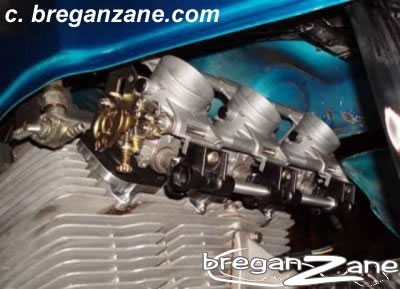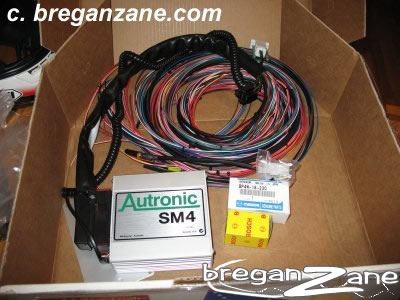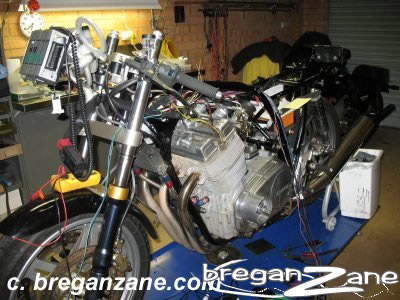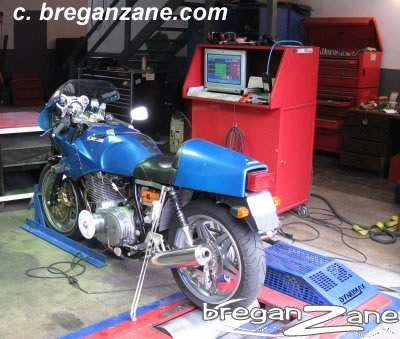ELECTRONIC FUEL INJECTION
For many years, in fact since I did the 1130cc 'tune up' to the RGA in about 1996, I've been playing with the idea of fuel injecting it. At that time it was still a little difficult due mainly to the lack of suitable hardware available - it was really only Bimota and Ducati playing with it at that stage. I was looking at having to scratch-build throttle bodies to suit, which didn't really appeal, also the costs were simply too high for me at that time. Instead I ended up picking up some cheap Mikuni CV's from a 1990 GSXR1100 and put them on, which produced an amazing improvement to the bike, but clearly there were far better solutions available. Keihin FCR's and Mikuni RS have both been used by various people with impressive results.
 The EFI project started in earnest in January 2006 with the purchase of some throttle bodies from ebay. One of the things that has made this conversion easier in the intervening years is the amount of hardware available from recent model mass market bikes. I chose bodies from a GSXR Suzuki as they looked particularly suitable for the task. I got also the rubber inlet manifolds from the Suzuki and made some aluminium adapter flanges up to fit these to the Laverda head pattern. Re spacing the throttle bodies was quite easy. So by June 2006 I had reached the point of the photo at right, the bodies were fitted to the head but the rest was unknown.
The EFI project started in earnest in January 2006 with the purchase of some throttle bodies from ebay. One of the things that has made this conversion easier in the intervening years is the amount of hardware available from recent model mass market bikes. I chose bodies from a GSXR Suzuki as they looked particularly suitable for the task. I got also the rubber inlet manifolds from the Suzuki and made some aluminium adapter flanges up to fit these to the Laverda head pattern. Re spacing the throttle bodies was quite easy. So by June 2006 I had reached the point of the photo at right, the bodies were fitted to the head but the rest was unknown.
Nothing tangible happened for a year or so while I finished the chassis side of things and tested the finished result over the Christmas/New Year period 2006-7 using the original Dellortos; the Mikunis having since been fitted to Christiane's RGSSFC here. In the background I had acquired a few types of fuel pumps and was looking into the options, finding plenty of packaging difficulties trying to fit all the required components in. There were also countless hours spent researching and trying to find various specific components that were required.
 In terms of an ECU, I had initially been leaning towards using a Microsquirt - a fully assembled, waterproof, miniature and very cheap ECU for fuel and ignition based on the open-source DIY Megasquirt. But being a 'home-brewed' project itself, the release was beset by multiple delays, and by July 2007 I just wanted the project underway and needed an ECU decision. After a lot of research I settled on an Autronic SM4, which came with very high praise and could handle all of the ignition and fuel requirements directly. The SM4 is a high-end ECU and although the cost is much higher than the Microsquirt, it is a far more advanced product with more capabilities. The Microsquirt has since been released and seems to be getting good reviews, but it's big disadvantage for a 120 is that it only has two ignition outputs, requiring an additional kludge to fire all three coils. It may still turn out to be a good budget ECU for use on a 180 or any type of twin.
In terms of an ECU, I had initially been leaning towards using a Microsquirt - a fully assembled, waterproof, miniature and very cheap ECU for fuel and ignition based on the open-source DIY Megasquirt. But being a 'home-brewed' project itself, the release was beset by multiple delays, and by July 2007 I just wanted the project underway and needed an ECU decision. After a lot of research I settled on an Autronic SM4, which came with very high praise and could handle all of the ignition and fuel requirements directly. The SM4 is a high-end ECU and although the cost is much higher than the Microsquirt, it is a far more advanced product with more capabilities. The Microsquirt has since been released and seems to be getting good reviews, but it's big disadvantage for a 120 is that it only has two ignition outputs, requiring an additional kludge to fire all three coils. It may still turn out to be a good budget ECU for use on a 180 or any type of twin.
With the arrival of the SM4 I really got going, there was so much that was simply 'unknown' and I had been mulling over options for various things for 12 months or so. In the end I just had to make an educated guess and try it. I ploughed ahead and designed and built the high pressure fuel system, cam sensor, cylinder head temp sensor, crank sensor and so on. The wiring harness for the SM4 is as much as the whole bike!
 By 15/9/2007 it was ready for a first firing, but problems with crank and cam sensors caused a two week delay while I sorted out some err... 'complications'. So on 1/10/2007 it was ready for the second try, the main culprit turned out to be that my cam sensor was not functioning properly at cranking rpm, and with no base settings to go from I was flying totally blind. Once I put the bike on my electric starter rollers and pumped the motor up to 1300rpm I suddenly had a stable spark and I could dial in the settings. It started on the first attempt and immediately ran and idled - I was pretty stoked! :-)
By 15/9/2007 it was ready for a first firing, but problems with crank and cam sensors caused a two week delay while I sorted out some err... 'complications'. So on 1/10/2007 it was ready for the second try, the main culprit turned out to be that my cam sensor was not functioning properly at cranking rpm, and with no base settings to go from I was flying totally blind. Once I put the bike on my electric starter rollers and pumped the motor up to 1300rpm I suddenly had a stable spark and I could dial in the settings. It started on the first attempt and immediately ran and idled - I was pretty stoked! :-)
Within half an hour I was riding the bike up and down the street, with no prior tuning experience I was very impressed with how easy the Autronic was to tune. This ECU does things differently from every other brand, much of the 'tuning' is already done in the background and fuel maps are very 'flat' compared with other brands. There is even a video of a fully tuned engine doing a run with full mapping, and then doing another pull from 2000-9000 rpm using one single fuel map point only, and making exactly the same peak hp. All the computations going on in the background are doing a lot of the work, and the fuel map is basically only for trimming.
 By the end of October I had replaced the Mazda cam sensor I initially used with a hall-effect one of my own design. This works down to stationary, so should get rid of all the problems I had with unstable spark during cranking. On 23/11 I booked the bike in for a dyno session to map the higher rpm points, it was just not practically possible to do it on the road. It took about two hours to dial it in, but I was very pleased with the outcome, hitting 93hp at the rear wheel with the very first wide open throttle run to redline. Some fiddling with fuel and ignition got me to 98hp, but we just couldn't crack the magic hundred. Still, pretty good for the first iteration, given this is not really a super-tuned engine and I didn't pull past 8000rpm. For means of reference a BMW R1150 makes 90hp on the same dyno, so all in all I was very pleased.
By the end of October I had replaced the Mazda cam sensor I initially used with a hall-effect one of my own design. This works down to stationary, so should get rid of all the problems I had with unstable spark during cranking. On 23/11 I booked the bike in for a dyno session to map the higher rpm points, it was just not practically possible to do it on the road. It took about two hours to dial it in, but I was very pleased with the outcome, hitting 93hp at the rear wheel with the very first wide open throttle run to redline. Some fiddling with fuel and ignition got me to 98hp, but we just couldn't crack the magic hundred. Still, pretty good for the first iteration, given this is not really a super-tuned engine and I didn't pull past 8000rpm. For means of reference a BMW R1150 makes 90hp on the same dyno, so all in all I was very pleased.
That very afternoon I took the bike off for the NSW Club's Snowy Rally and did the ride out on the Saturday. Aside from some fuel supply issues to the pump, the bike ran like a clock, with just a small mapping glitch just coming off a trailing throttle. Things are looking pretty good at this early stage. I am hopeful that with some further optimisation in a few areas there will be another 10-15hp available without sacrificing the strong midrange of this motor as it is now.
If you're interested in EFI for your Laverda drop me a line (steve at breganzane dot com), I'll consider a small production run if there is enough interest. However first I need to finish development of this one and do a fair bit of reliability testing.
Stay tuned....

